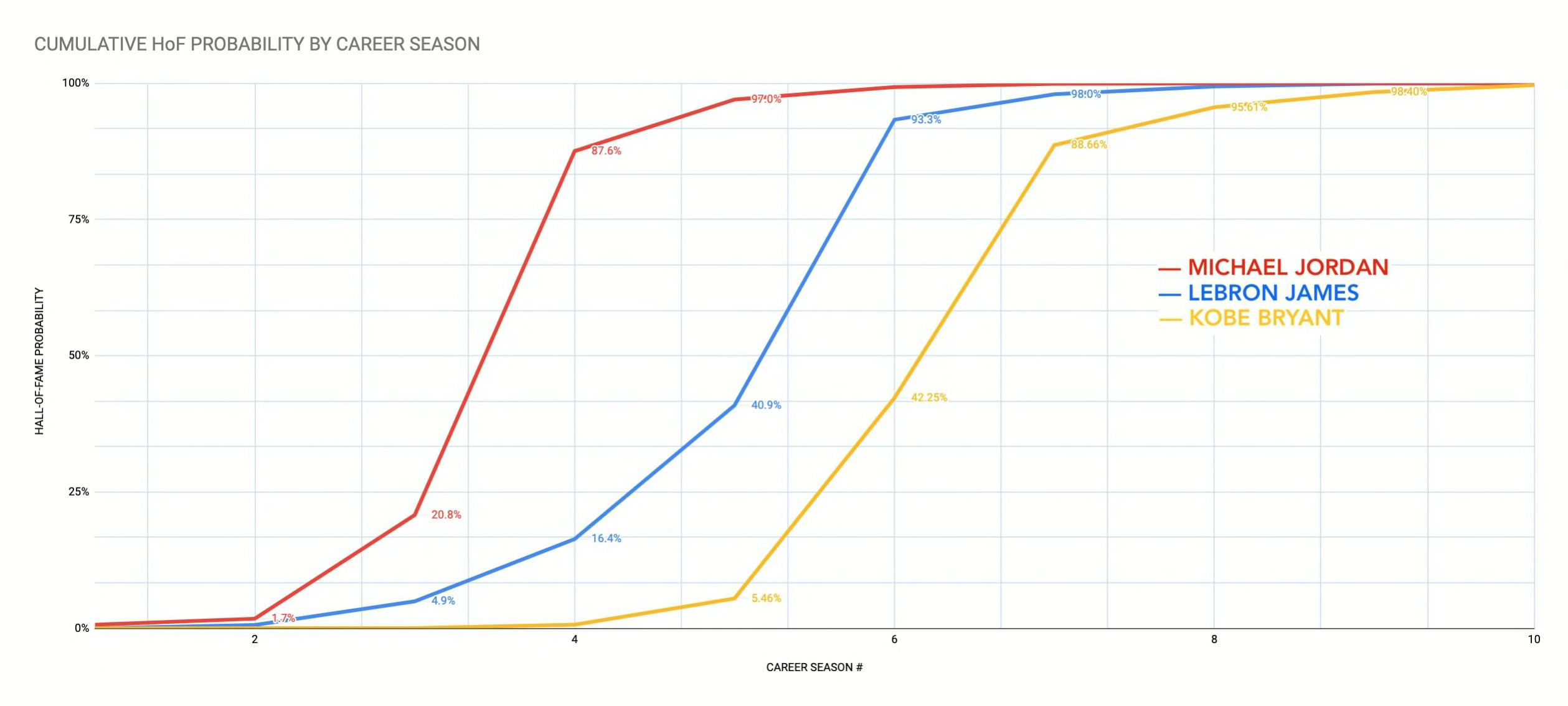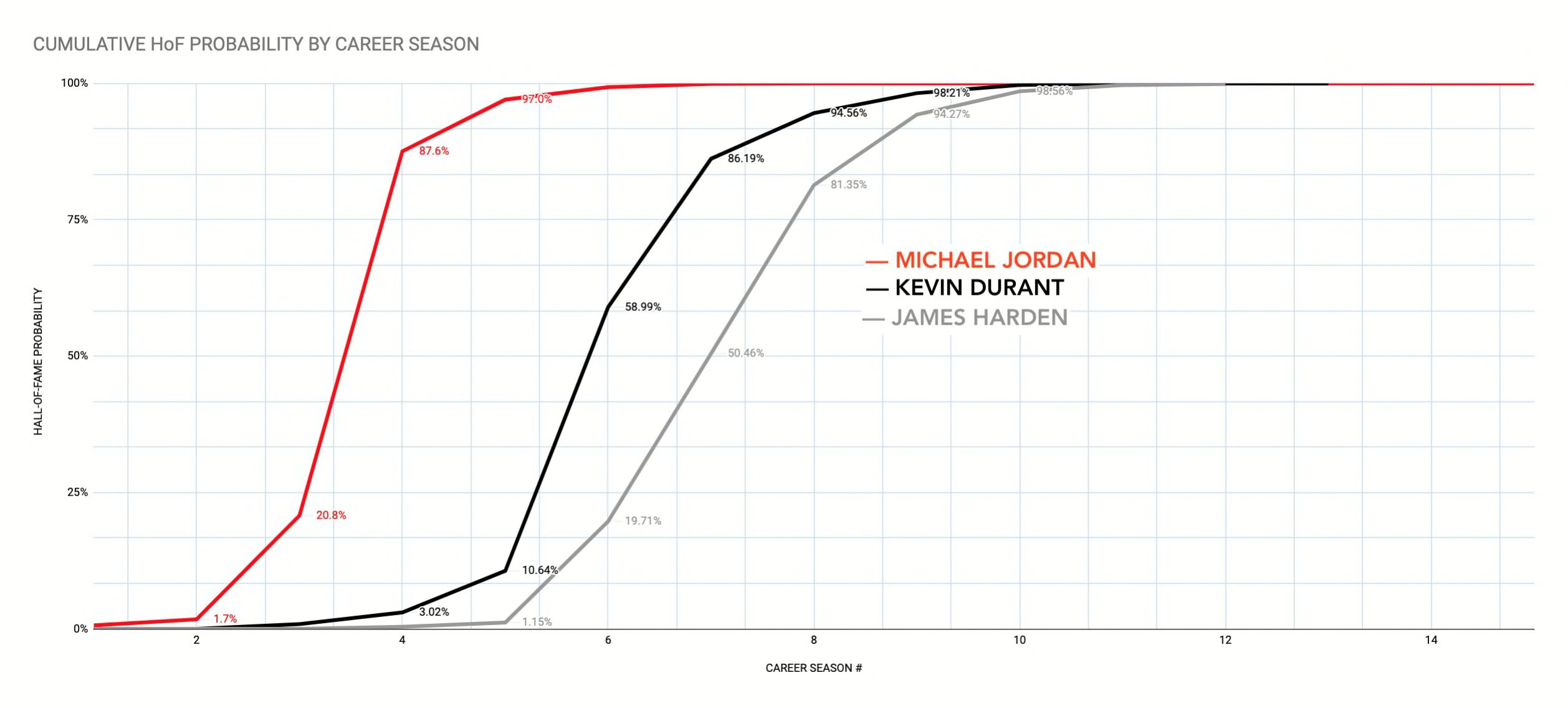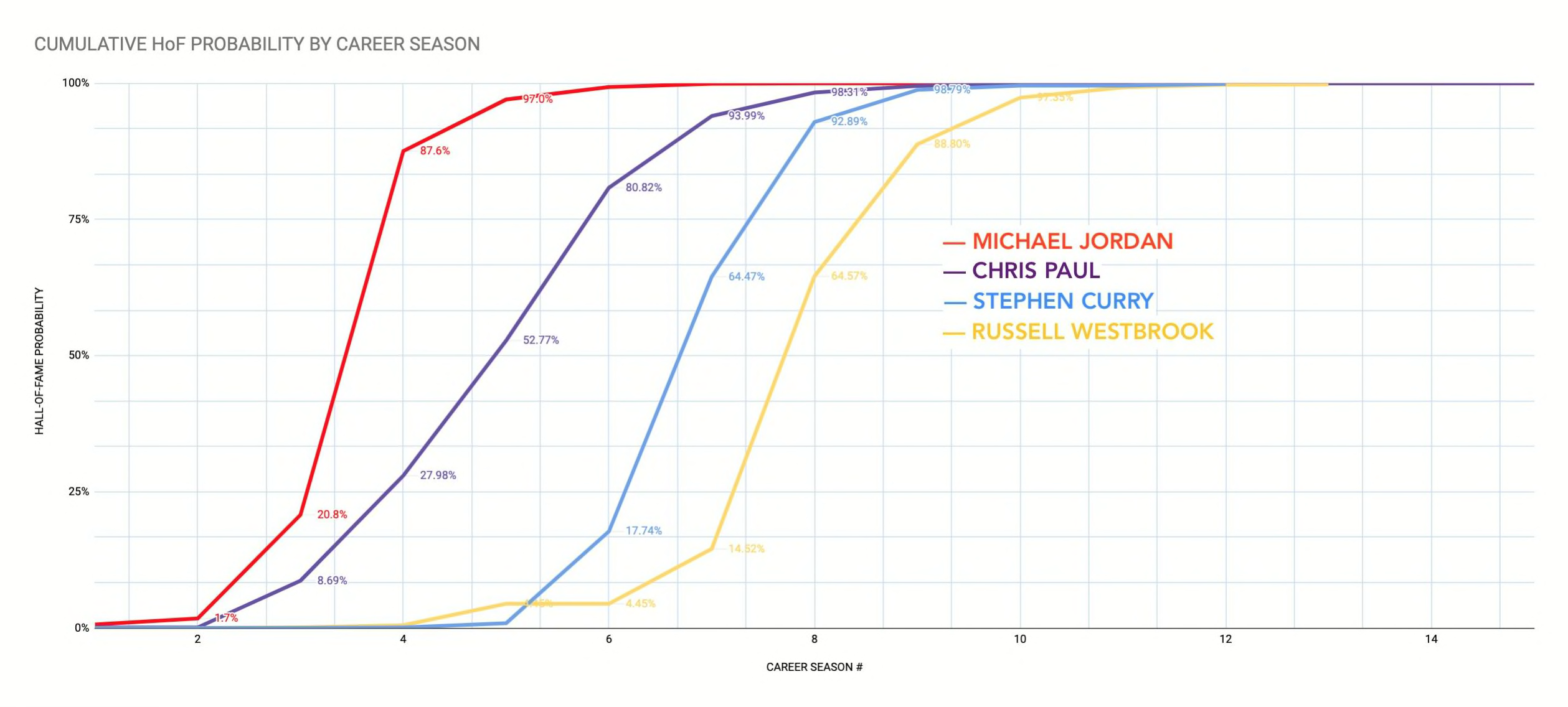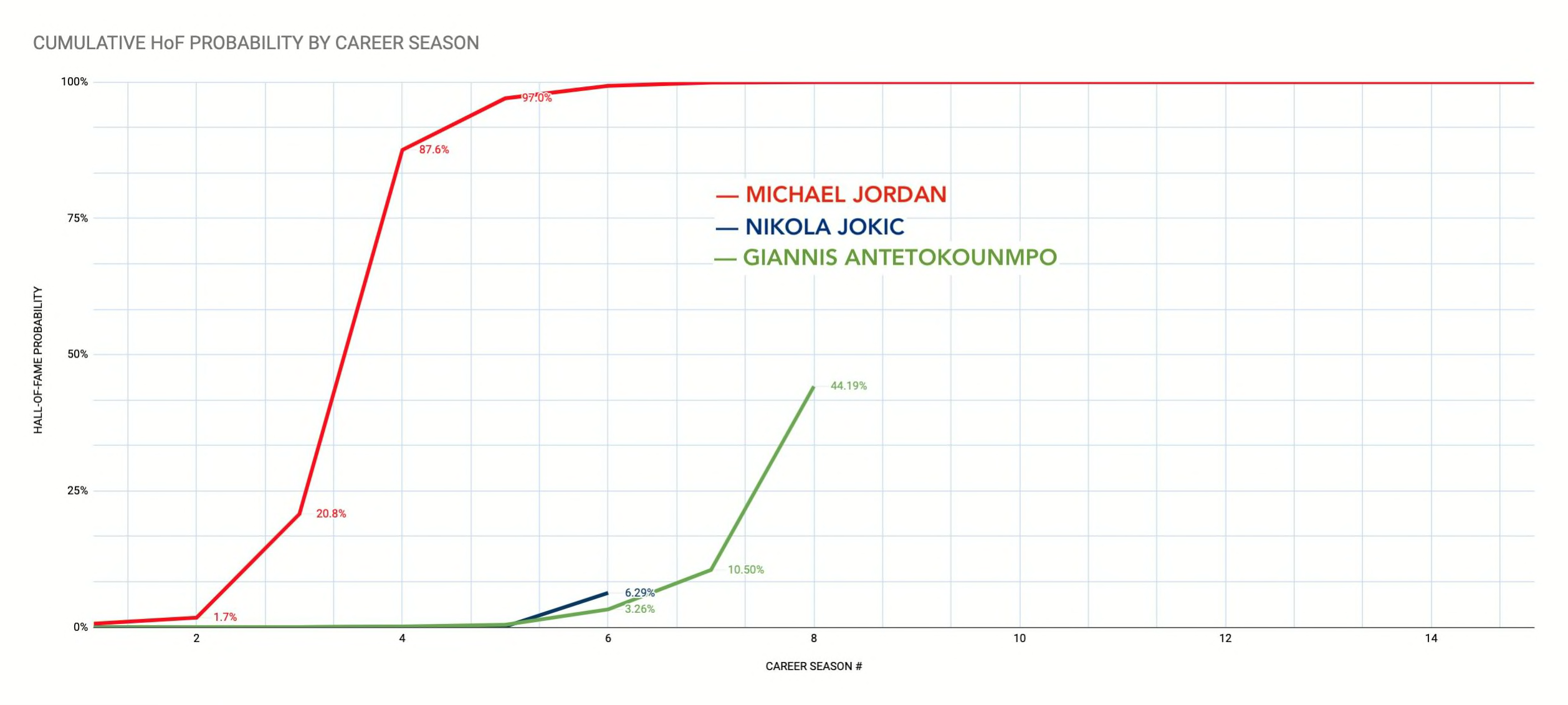The Whiteboard is The Step Back’s daily basketball newsletter, covering the NBA, WNBA and more. Subscribe here to get it delivered to you via email each morning.
I have to admit, I am fascinated by Basketball-Reference’s Hall-of-Fame probability model. If you’re not familiar with it, the model uses several key stats to measure the likelihood of a player being inducted into the Naismith Basketball Hall-of-Fame once they retired. (It’s also calculated retroactively for retired players who have and have not been inducted). The model uses just a few measures to try and answer a fairly big question:
“For the Hall of Fame problem, we tried to use as many predictor variables as we could. Player awards, sustained effectiveness as measured by appearances on leaderboards, and peak dominance (measured as a player’s peak Win Shares output), all have explanatory value. Number of championships is a strong predictor, as well, along with the player’s height.
…
Players receive points for appearing on leaderboards, receiving 10 points for leading the league in a category and 1 point for finishing 10th. This seems like a fair way to award credit for both black and gray ink. The eligible statistical categories include PTS, TRB, AST, MP, STL, BLK.”
I find the model so fascinating because it’s not meant to measure a player’s overall value, we have plenty of other models and metrics that do that with varying degrees of success. Rather, it’s an attempt to measure the perception of value. It’s a model that tries to capture which players we, collectively, believe are worthy of honoring after they’re done playing.
As a pure measure, the output Hall-of-Fame probability is a bit esoteric, mostly because it’s the probability of a binary outcome — players are either in or they’re not. The highest Hall-of-Fame probability for an eligible player not in the Hall-of-Fame is Larry Foust (94.2 percent) a 6-foot-9 center who played in the 1950s and early 1960s. His exclusion could be chalked up to historical quirk but every other eligible player with a probability of 80 percent of above has been inducted.
However, there are plenty of outliers in the other direction. Ben Wallace was inducted this year despite a probability of just 45.3 percent. Chris Webber was even lower — just 14.6 percent. Needless to say the model is not perfect and the granularity of the output itself doesn’t necessarily hold a lot of added value. For example, there are 55 players with a predicted probability of 99.5 or above. Does the numeric difference between Ray Allen (99.9 percent) and Kobe Bryant (100.0 percent) reflected how they are treated in the general legacy discourse?
How did Michael Jordan, LeBron James and Kobe Bryant build their Hall-of-Fame resumes?
Still, I thought it would be fun to play around a little bit and look at how several NBA greats built their Hall-of-Fame legacies (probabilities) season by season. For example, the graph below shows the cumulative Hall-of-Fame probability for Michael Jordan, LeBron James and Kobe Bryant after each season of their careers.

Obviously, Michael Jordan was on a pace all his own. For basketball fans of my generation (I was born in 1981) who know the legacy of Jordan primarily through his two three-peats, it’s easy to miss just how incredible he was right from the jump. I looked at nearly a dozen current and future Hall-of-Famers for this analysis (more on that later) and his cumulative probability of 1.7 percent after two seasons was roughly 15 times higher than any other player. And, remember, he only played 18 games in his second season because of a broken foot.
By the end of his fourth season, Jordan had already made four All-Star teams, posted a peak Win Shares of 21.2 (still the best season by any player in the 3-point era as measured by Win Shares) and won two scoring titles. His cumulative Hall-of-Fame Probability at that point was 87.6 percent. LeBron didn’t pass that threshold until his sixth season, the year he won his first MVP. Kobe didn’t reach that threshold until his seventh season, at which point he had already won three titles.
You could almost argue that Jordan had two separate Hall-of-Fame worthy careers. Over his first six seasons, before ever winning a title, he built up a 99.3 percent Hall-of-Probability with six All-Star Appearances, that 21.1 Win Share peak season and four scoring titles, while leading the league in steals and minutes played twice each. And then he went on to six championships.
You’ll also notice that every player has essentially the same curve (a product of an exponential term in the model), they just have slightly different slopes and start rising at different points. Each successive All-Star appearance adds more value than the previous (a third selection adds more probability than a second, etc.) and that’s one of the reasons Jordan gets such a huge jump on Kobe and LeBron. Jordan was an All-Star from his very first season. Kobe first made an All-Star team in his second season and didn’t make the team in his third. LeBron didn’t make the team as a rookie and so started building up that part of his resume a year behind Jordan.
Kobe and LeBron are also an interesting comparison in that the early building blocks of their Hall-of-Fame resumes were so different — Kobe had early titles, LeBron had early statistical dominance. In the eight seasons before he first won a title, LeBron accrued 141 leaderboard points along with a peak Win Share season of 20.3. In his first eight seasons, Kobe won three titles but had a peak Win Share season of just 14.9 and had only accrued 38 leaderboard points.
From here, I was curious if I could find anyone else whose arc came anywhere close to Jordan. I looked through a few future Hall-of-Famers — all of whom are still active and have Hall-of-Fame probabilities of 99.9 percent or higher and each of whom had, anecdotally, some combination of early statistical or championship success that might have been in the ballpark. Spoiler alert, they weren’t.
I started with two of the more dominant modern win scorers — Kevin Durant and James Harden.

Harden obviously got a late start, not really taking off the statistical front until he was traded to Houston. But even Kevin Durant, who was an All-Star and scoring champion by his third season, wasn’t even close. Next, I looked at three future Hall-of-Fame point guards — Chris Paul, Russell Westbrook and Stephen Curry.

Chris Paul was interesting, people forget just how good he was in his first few seasons. By the end of his fourth season, he had already led the league in assists twice and steals three times. But he also didn’t make an All-Star team until his third season and, obviously, a championship still eludes him. Westbrook also had one of the most unique curves, and you can pretty easily spot the season he missed so much time with a knee injury, as well as the point Durant left Oklahoma City and Westbrook’s triple-double hunt finally put him on a Hall-of-Fame trajectory.
For fun, I also looked at two young players who seem to be on Hall-of-Fame trajectories early in their careers — Giannis Antetokounmpo and Nikola Jokic.

Obviously, we’re nowhere near Jordan territory but you can see the relative value of what both players did last season — a championship for Giannis kicking his legacy up a notch and a dominant statistical season from Jokic actually putting him ahead of where Giannis was at this point in his career.
In the end, this is all just a curiosity. Everyone here is or is going to be in the Hall-of-Fame and once you’re in they don’t make distinctions for how you arrived.
#OtherContent
Many different teams have been floated as potential landing spots for Ben Simmons. But where would watching him be the most fun?
Michael Porter Jr. spoke with FanSided’s Mark Carman and made some bold claims about just how good the Nuggets can be this season.